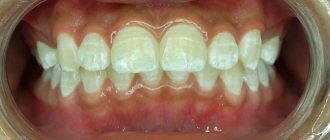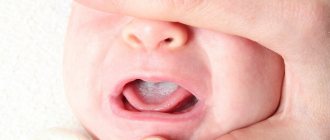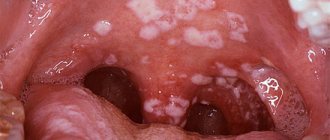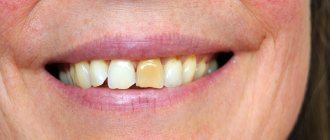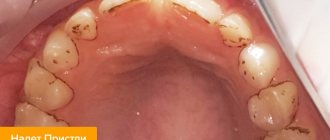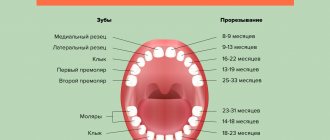Many parents sooner or later wonder why white spots form on their child’s front and chewing teeth. This phenomenon can occur for many reasons, so it is important to consult a doctor as soon as possible to identify them and then prescribe effective treatment.
If the problem is not associated with a pathological process and is just an aesthetic defect, you can cope with it by following the dentist’s recommendations at home. When the situation is advanced, serious dental intervention in the clinic using a drill and filling cavities cannot be avoided.
It is better to prevent pigmentation from occurring, because the problem is much easier to prevent than to treat. Experts have developed a set of recommendations that help prevent the appearance of whitish spots.
White spots on baby teeth in an infant and older child
This is an alarming symptom that requires urgent consultation with a pediatric dentist. Some parents mistakenly believe that there is no need to treat the first teeth, because they will soon fall out and be replaced by permanent ones. This is a misconception that can cost your oral health.
Whitening of areas indicates their demineralization. If urgent measures are not taken, the unit may simply fall out or split into several fragments. As a result, the rudiments of new incisors, canines and molars are damaged. You won't be able to deal with this on your own. For treatment, therapeutic tactics are developed together with an experienced specialist in the field of pediatric dentistry.
Factors influencing the development of superficial caries in children
The fundamental factors that result in superficial caries in children are:
- eating foods that contain large amounts of carbohydrates;
- non-compliance with hygiene rules: insufficient brushing of teeth, ignoring periodic rinsing with special means, etc.;
- drinking water with a deficiency of fluoride in its composition;
- deficiency of vitamins and mineral elements;
- severe systemic diseases;
- hormonal imbalance;
- ignoring professional hygiene, the need for which arises every 5-6 months.
Any of these factors or several at once are the primary causes of tooth enamel destruction.
White spots on molars
This phenomenon occurs much less frequently than in the case of dairy rows. The process is often observed when installing a bracket system. The problem is provoked by an unbalanced, irregular diet, insufficient consumption of fresh vegetables and fruits, and milk. If this is really the root cause, it is enough to change the diet or reinstall the corrective orthodontic structure.
In adolescence, whitened areas often indicate the onset of caries development. If you contact a dental clinic in a timely manner, you will not need drilling of the affected tissue, filling or cleaning of canals after forced removal of the nerve.
Possible complications
Some parents are in no hurry to visit a pediatric dentist because they consider it useless to treat baby teeth. This approach is explained by the fact that permanent ones will grow instead of them anyway.
Although the carious process itself does not transfer from baby teeth to permanent ones, untreated caries lesions have a detrimental effect on the condition of the latter. If you ignore superficial caries in children , complications may very soon manifest themselves:
- caries progresses rapidly in the absence of adequate therapy. This leads to the development of periodontitis and damage to the molar tooth germ. The inflammatory process significantly slows down the eruption of permanent teeth and complicates their growth;
- premature loss of baby teeth leads to the formation of malocclusion and disrupts the structure of the maxillofacial system;
- If at least one tooth is missing in the dentition, this complicates the process of chewing food. As a result, problems arise with the functioning of the digestive system.
Remember! Even the smallest stain can lead to complete tooth decay. There is no need to risk your child's health. It is much easier to visit the dentist and, if necessary, treat caries.
Causes of white spots on a child’s teeth
The problem can arise due to many factors. The most common of them:
- Hypoplasia. This is severe thinning, partial or complete absence of enamel.
- Caries. A natural result of poor quality care and untimely visit to the dentist for preventive purposes.
- Fluorosis. This term refers to an excessive concentration of fluoride in a child’s body.
- Wearing orthodontic appliances. Hygiene is difficult, so carious lesions often occur.
- Injury (including dairy rows).
- Decreased immune defense, frequent colds, viral infections.
- Failure to comply with simple hygiene requirements.
It is worth dwelling on each of the reasons for the occurrence of white spots on teeth in infants and children of an older age category.
Enamel hypoplasia
This is a congenital non-carious pathology of dental units, when a complete or partial absence of the enamel layer is diagnosed. The appearance of incisors, canines and molars changes significantly. Not only whitish areas appear on them, but also grooves and depressions.
The disease is associated with the abnormal structure of hard tissues. It is often accompanied by carious lesions, increased sensitivity to hot and cold foods, sour and sweet foods.
The anomaly originates during the period of intrauterine development or under the influence of external factors. Most often the problem is provoked by:
- Rh conflict between mother and fetus;
- infections suffered by a pregnant woman;
- late gestosis, premature delivery, birth injuries;
- poor nutrition of the expectant mother, taking prohibited medications;
- traumatic effects on the baby’s maxillofacial area;
- endocrine disorders;
- diseases of the gastrointestinal tract, nervous and urinary systems.
Caries
If white spots appear on a child’s teeth, mom and dad most often do not even suspect the presence of carious lesions. The sooner the problem is diagnosed, the faster and easier it will be solved. In the earliest stages, it is often possible to avoid drilling with a drill, which is extremely important when treating small patients. In this case, remineralization or fluoridation is used.
If you do not intervene in time, the enamel will become even thinner, softer and begin to collapse. You can feel the rough surface to the touch.
The spots remain whitish for a short time, they darken. At the same time, infectious agents penetrate into the deepest layers of the crown and root, causing more serious dental diseases that are difficult to treat.
Excess or lack of fluoride
Excessive concentration of the substance in the body is called fluorosis. It reaches a small person through drinking (in some regions the water supply contains excessively fluoridated water), food (seafood), pastes, medicines and polluted industrial air.
Growing teeth are most susceptible to damage, so the problem is more often detected in children. Children with weak immunity and chronic pathologies are especially vulnerable.
Not only excess, but also deficiency of fluoride can provoke a number of dental disorders. Low fluoride content leads to caries and gum disease.
Braces and the consequences of wearing braces
White spots on a child’s permanent (molar) teeth (photos can be found on the Internet) are also observed when orthodontic appliances are installed. This is primarily due to insufficient hygienic care of the oral cavity. In children wearing braces, a layer of plaque accumulates, and the enamel may become lighter.
During the correction period, it is important to take good care of your incisors, canines and molars. It is worth cleaning them at least 2 times a day, morning and evening. You need to give up sweets, confectionery, and sour foods. All this leads to pigmentation.
Injuries
Any mechanical impact threatens damage to the enamel, because this layer is naturally quite thin and fragile, especially in young patients. Whitish spots appear on damaged areas as a response to injury.
In modern dentistry, there are cases where blows and falls in childhood led to the appearance of light pigments in adulthood on permanent units.
Damaged rows not only look unsightly, but can also collapse.
Weakened immunity
Numerous medical studies have shown that children, who are most susceptible to colds and viral infections, suffer from mineral deficiencies and inadequate immune defenses. As a result, white spots (stripes, chalky zones) form on the teeth of a one-year-old child.
Special pastes and traditional therapy, of course, can help in the initial stages. However, first of all, it is recommended to visit a dentist to identify the causes of the symptom and prescribe effective comprehensive treatment.
Abuse of bleaching products and procedures
In patients who abuse such manipulations and regularly use whitening compounds, certain areas of the enamel often become lighter. It does not matter who performs the procedure, a professional dentist at a high price or a loving parent at home.
Such incisors, canines and molars look unaesthetic. For this reason, most doctors note the need for subsequent remineralization. With its help, you can not only make your teeth aesthetically attractive, but also strengthen your enamel.
Poor hygiene
Even the youngest patients know that poor quality care leads to a host of dental problems. Children wearing braces especially suffer from this.
As soon as the baby's first central incisor erupts, you can buy a special finger brush and brush your teeth 2 times a day. However, even if teething is still very far away, you still need to take care of your oral cavity. To do this, you can wipe your gums with a piece of gauze or clean cotton cloth soaked in boiled water or herbal decoction.
Features of superficial caries
Among the main distinctive features of superficial carious damage to teeth in children in comparison with other forms of pathologies, the following should be noted:
- only the enamel layer is affected by pathogenic formations. The dentin remains intact. With timely treatment, the risks of complications are minimal;
- the occurrence of an acute reaction to external stimuli, for example, sour and sweet foods, low and high temperatures;
- if superficial caries is diagnosed in children, treatment can be carried out without tissue preparation;
- Most often, the superficial form occurs in children aged 3-4 years and in adolescents.
Note! Initial caries and superficial caries are two completely different forms. The first appears as a small spot, the second occurs in the absence of treatment. It can be recognized by the presence of small-sized carious cavities.
Is it possible to fix the problem at home?
Therapeutic tactics depend on the causes of the disease. If the problem is unsuitable water, it is enough to replace it with bottled water or install special filters in the house that remove fluoride from the liquid. The same goes for toothpastes and medications. It is important to avoid fluoride-containing foods.
When a child has grown teeth with white spots, you need to introduce foods rich in calcium and vitamins into his diet. For example, you should eat more vegetables, cheese, and drink milk.
Often the provoking factor is insufficient oral hygiene. Parents must teach their son or daughter how to properly perform hygiene procedures. Any available and effective teaching methods will do. Currently, there are many educational cartoons and programs that will help you learn all the intricacies of regular cleaning in a playful way.
Why good oral hygiene is important
You need to brush your teeth twice a day with a properly selected toothpaste and brush, and floss after each meal. Why do white spots appear on teeth even when hygiene rules are followed?
Sometimes the cause of thinning enamel is the constant use of highly abrasive toothpastes. There are patients who try to use “grandmother’s” cleaning recipes, not taking into account their traumatic nature for the enamel. In this case, the hygienic procedure will only speed up the transformation of a small spot on the tooth into a full-fledged carious area.
Using a standard toothbrush on your own cannot remove all microparticles of food or remove pathogenic microflora. Therefore, regular professional cleaning using special equipment in the clinic is necessary.
Traditional methods of treatment
Adherents of “grandmother’s” methods should resort to them only in cases where the contrasting white spots on the child’s teeth are purely a cosmetic defect and the doctor gives instructions for treatment at home. For example, you can rinse your mouth with a weak solution of table vinegar (2 teaspoons of the substance per 1 spoon of salt and a glass of clean boiled water). This way you can get rid of plaque and restore the balance of minerals. The only disadvantage of this product is that the baby may swallow it out of curiosity or accidentally, so this method is recommended for older children.
There is also a safer strengthening composition for enamel. We are talking about green tea. It contains flavonoids, as well as gallic and chlorogenic acids. With regular drinking of the drink, pigmentation will completely disappear. In addition, the condition of the mucous membranes in the mouth will significantly improve.
How to get rid of white spots on teeth
First of all, it is important to consult a doctor to find out the causes of the unpleasant symptom. The pediatric dentist will determine what caused the whitish formations on the teeth, select effective therapeutic methods, and give recommendations for high-quality hygienic care and prevention.
If a carious lesion is detected at the initial stage, no serious intervention is required. In most cases, it is sufficient to use silvering (on primary occlusion), remineralization or ozonation (in the presence of permanent rows). The baby must be taught proper hygiene.
When caries is deep and painful, you cannot avoid using a drill and installing filling material. When the pathological process is advanced, depulpation and even extraction (removal) are indicated.
If an excess of fluoride is detected in a child’s body, the doctor will advise using a paste that does not contain this component. Remineralization is also indicated.
When tooth surfaces become white due to braces or other orthodontic structures, complex treatment is carried out, which includes:
- elimination of carious cavities;
- disinfection;
- replacement of simulators with new ones;
- regular dental monitoring;
- professional cleaning of food debris and accumulated plaque.
Types of fluorosis and manifestations
The disease has many forms, each of which has its own symptoms, so only an experienced dentist can diagnose the disease.
Forms of fluorosis:
- Streak fluorosis is the appearance of barely noticeable stripes on the surface of the enamel of the front teeth; they can most often be diagnosed only when visiting a dentist for other reasons.
- Spotted fluorosis is whitish spots of varying sizes, sometimes merging into a single pigment spot.
- Chalky-mottled fluorosis - the appearance of pigmented dots and spots up to 0.2 mm deep. Such spots may have a yellow tint, and the bottom of the spot may be brown.
- Erosive fluorosis is a large lesion that covers most of the tooth surface. Otherwise, such a lesion is called erosion of tooth enamel.
- Destructive fluorosis is a serious form of the disease that leads to tooth destruction and rapid wear of enamel.
Prevention of the problem
To prevent the appearance of white spots on the enamel of teeth in children, you need to follow simple preventive recommendations:
- Take your child to the dentist at least twice a year. If you have a predisposition to caries or a malocclusion has been diagnosed, it is recommended to do this more often, approximately every quarter.
- Monitor the quality of care for dental units and the oral cavity as a whole.
- Watch your diet. Nutrition should be complete, varied, balanced. It is important to include products of both plant and animal origin in the menu.
- It is necessary to reduce the consumption of confectionery products, sweet soda, and baked goods.
- Give your baby multivitamins and mineral complexes after illnesses and during periods of active growth and development (strictly in consultation with the doctor).
- Stick to a diet during pregnancy. It is worth including more dairy products and plant foods in your diet.
- Do not use tetracycline during the gestational process, as this substance has a detrimental effect on the enamel.
- Treat all diseases in a timely manner, preventing them from becoming chronic.
- Carry out oral care after the appearance of the first incisor.
- Preschoolers under 4 years old should not buy pastes with fluoride; monitor the level of the element in tap water.
- Listen to the opinion of specialists and avoid self-treatment.
Brown spots
Similar manifestations on tooth enamel are also caused by the development of hypoplasia. The disease is generally very common and, according to some estimates, affects up to 40% of children.
The causes of hypoplasia, in contrast to caries, which destroys still growing teeth, are complications during pregnancy or trauma during birth. It can also develop due to poor nutrition, digestive problems and damage to tooth enamel.
For prevention, it is necessary to monitor the condition of the mother’s teeth. You should stop artificial feeding and monitor the child’s nutrition subsequently, as well as regularly visit the dentist.
Let's sum it up
White spots on growing children's teeth do not always indicate the presence of a pathological process. Despite the positive statistics, you should not do anything on your own or self-medicate without consulting a doctor. You cannot delay a visit to the dental clinic, because it is much easier to get rid of the problem at the initial stage than in advanced cases associated with deep damage.
Sometimes light spots on the enamel indicate serious systemic pathologies, and a simple examination by a dentist will not be enough. Additional tests and advice from specialists will be needed.
By following preventive rules, you can prevent the appearance of light spots. It is important to teach your child to regularly care for his mouth and periodically show him to the dentist.
Caries in the spot stage: diagnostic measures
The most reliable and effective diagnostic procedure for the initial form of caries is to check the integrity of tooth enamel using special organic dyes. Dentists use:
- carmine;
- tropeolin;
- methylene red;
- methylene blue.
The latter is more often used in dental practice. First, the specialist removes accumulated plaque from the tooth surface. Use cotton swabs to isolate the tooth from saliva and then apply the coloring solution. After a few minutes, the solution is thoroughly washed off and the condition of the enamel is analyzed. If it is stained, this indicates the presence of caries.
There are other ways to diagnose caries in the spot stage:
- drying of enamel. The surface of the tooth is treated with a solution of hydrogen peroxide, then the enamel is thoroughly dried with a stream of warm air. After drying, areas with white spots will immediately become noticeable;
- radiography. The area affected by caries appears as a small spot on an x-ray. The method is used mainly for contract caries;
- examination with a stomatoscope. First, all accumulated plaque is removed from the surface of the teeth, then the dentition is illuminated with the device. Under ultraviolet radiation, it is not only easy to distinguish damaged tissue from healthy tissue, but it is also possible to determine the boundaries of pathology.
In order to treat caries in the spot stage, it is very important to undergo a timely diagnosis, accurately recognize the presence of pathology and exclude similar diseases that resemble caries.
